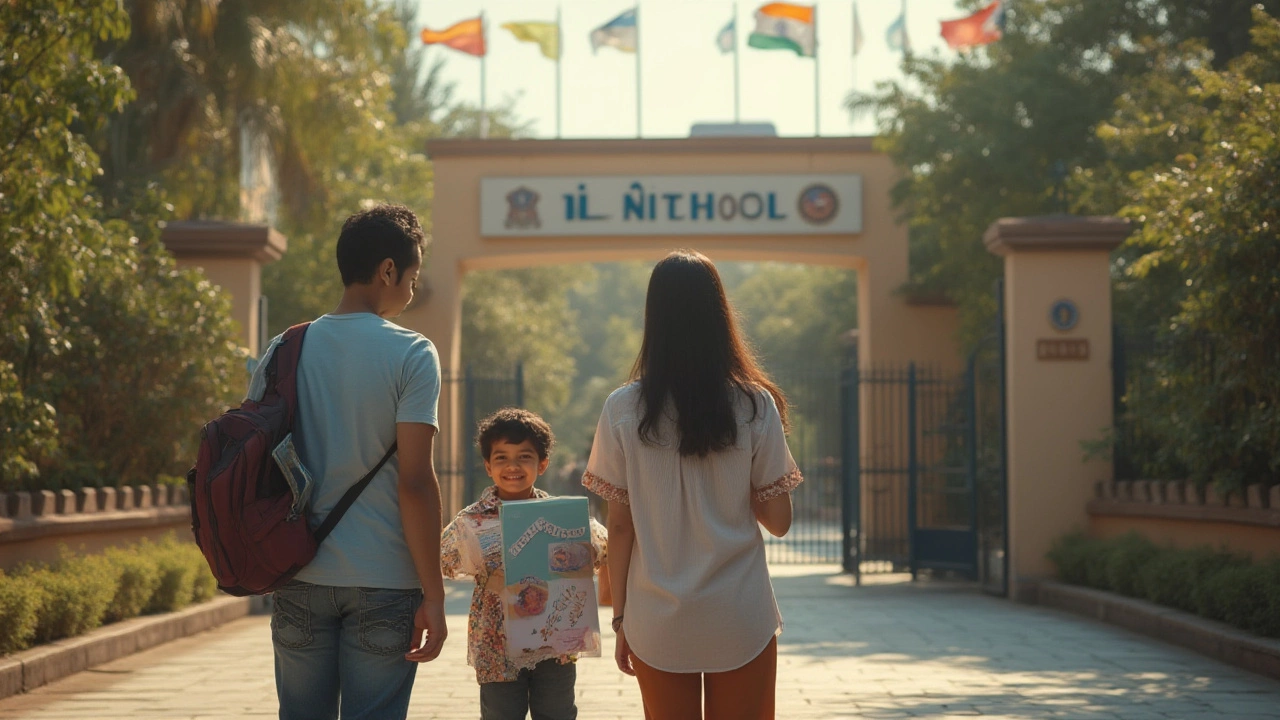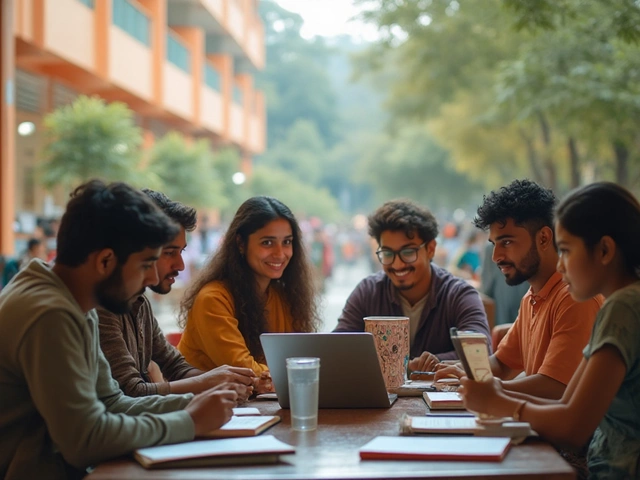Thousands of Indian families uproot themselves every year for work or business, moving to far-off places like Dubai, Singapore, or even Nairobi. Your first panic might not be about language or the food. It’s schooling for your kids—especially if you want them to keep up with the Indian curriculum. But is the CBSE, India's colossal education board, really available outside India?
CBSE: A Snapshot for Globe-trotting Families
If you’re an Indian parent overseas, you probably already know the full form of CBSE abroad—Central Board of Secondary Education. It’s almost everywhere in India, but how far does its reach actually go? The surprising answer: CBSE isn’t just a homeland phenomenon. It’s quietly expanded worldwide, carving out a space for Indian expats, and even curious international students, from the sandy suburbs of Abu Dhabi to the calm city zones of Tokyo.
CBSE wasn’t always international. For decades, it stuck to Indian borders. But the steady march of global Indian migration—think of tech professionals in Silicon Valley, expats in Muscat, diplomats in Geneva—made parents anxious about switching kids to unfamiliar education systems. The CBSE stepped up, approving a pioneering batch of international schools starting with the Gulf countries in the late 1970s. They now reach students in more than 28 countries. As of July 2025, over 240 schools outside India hold CBSE affiliation. The United Arab Emirates alone has more than 80 CBSE-affiliated institutions. Pick a random international school in Gulf cities like Dubai, Doha, or Manama—odds are, you’ll see CBSE on a signboard.
The boom isn’t accidental. Kids can slide right back into Indian colleges or competitive exams after stints abroad if they stick with the CBSE path. And it’s not limited to big cities: smaller expat enclaves in Africa, Southeast Asia, and Europe are home to CBSE schools too. This global spread keeps Indian communities feeling grounded no matter where they live.
Where to Find CBSE Schools Outside India
If you’re wondering where you might find CBSE schools, the Gulf region is ground zero. The United Arab Emirates is the undisputed hub—Dubai, Abu Dhabi, Sharjah, and Ajman together sport around 85 CBSE schools, teaching more than 300,000 students. Oman, Qatar, Bahrain, and Kuwait follow closely. But you can spot CBSE-aligned schools farther afield—in Singapore, Malaysia, Bangladesh, Nepal, Maldives, Indonesia, Saudi Arabia, even Japan and Russia.
Here’s a quick look at the top countries for CBSE schools, with real student numbers as of early 2025:
| Country | Number of CBSE Schools | Estimated Student Base |
|---|---|---|
| United Arab Emirates | 85 | 320,000+ |
| Oman | 14 | 38,000 |
| Qatar | 12 | 32,000 |
| Kuwait | 10 | 27,000 |
| Bahrain | 9 | 22,000 |
| Singapore | 4 | 5,500 |
| Malaysia | 3 | 3,700 |
| Other countries | Ca. 40 | 15,000 |
Some of these schools—like The Indian High School in Dubai, Delhi Public School branches worldwide, or the International Indian School in Dammam, Saudi Arabia—are almost household names in expat circles. They don’t just follow the same books and exams as schools in Delhi or Mumbai; they fly in Indian teachers, celebrate Indian festivals, and prepare kids for the same board exams as their cousins back home.
But there’s a twist. A handful of these international CBSE schools aren’t just for Indian nationals. They accept kids from a broad range of backgrounds. You might find children from Nepal, Bangladesh, Pakistan, or local families who want their child exposed to an internationally portable, English-medium Indian syllabus.

How Different Is CBSE Abroad from CBSE in India?
If you expect the CBSE experience abroad to be just cut-paste from India, think again. Sure, the curriculum, textbooks (NCERT mostly), and board exams are technically identical. But the international experience adds a few layers. For one, there’s a real mix of cultures in the classroom—Indian traditions meet local holidays, dress codes vary more, and there’s often a little more flexibility with languages. For example, in UAE schools, students may study French or Arabic as part of their language electives.
Some overseas schools bundle CBSE with IB or Cambridge programs, offering transitions or options for families who might move again. Facilities are often slicker too. Many Gulf CBSE schools sit in big campuses with indoor swimming pools, robotics labs, and top-notch sports complexes. Technology integration—online classes, digital boards, school apps—got a big boost after the pandemic, sometimes even outpacing India-based schools.
But the biggest difference? The support structure. Teenagers navigating an expat community might need extra social support, especially if one parent is on a rotating work schedule. That’s why most successful CBSE schools abroad double as community hubs. They organize Bollywood nights, Indian dance classes, or even host cricket leagues—keeping cultural ties alive.
Despite all the positives, there are challenges. Teachers might come and go faster than in stable Indian jobs, which can unsettle kids. Visa and work laws in some countries can make hiring qualified Indian staff tough. Also, fees are much higher compared to regular India-based CBSE schools; in Dubai, annual tuition for senior classes often hits $4,000 to $8,000 (₹3.3 to ₹6.7 lakh) per year. Unlike India, there are fewer state scholarships or fee waivers. Admissions can get competitive in popular schools, especially in the Gulf region.
Admissions, Syllabi, and Examinations: What Parents and Students Should Know
Applying to a CBSE-affiliated school overseas follows a similar route as in India: birth certificates, past academic records, passport copies, and sometimes an entrance test for competitive grades. Don’t expect last-minute admissions—in cities like Doha or Muscat, seats fill up months in advance, and places are even more in demand for classes 9 to 12 (where board exams start mattering for college admissions).
- Uniforms & School Life: Uniforms usually mirror the Indian pattern—white shirts, navy or khakhi bottoms—but local weather and customs sometimes add a twist.
- Language Policies: English remains the main language, but many schools offer Hindi, French, Arabic, or other local language options.
- Subject Choices: Most CBSE patterns apply, especially Science, Commerce, and Humanities streams. Optional subjects (like Mass Media, Computer Science, or Home Science) depend on local resources.
- Board Exams: Overseas CBSE schools conduct the exact same Grade 10 and Grade 12 board exams as India. Papers are couriered with strict supervision. Results are released globally at the same time—usually in May every year.
- Fees & Costs: Tuition ranges dramatically: smaller countries like Nepal or Bangladesh may charge under $1,500 per year, while larger Gulf schools hit $8,000+. Transport, uniform, and activity fees are extra. Some companies pay all or part of this for their expat employees.
- Special Support: Counseling and guidance for NRI or PIO (Person of Indian Origin) students is widely available—especially for those aiming for competitive Indian entrance exams like IIT-JEE or NEET, even from abroad.
Let’s clear up a misconception: having a CBSE certificate from Dubai, for instance, is as valid as one from Mumbai. Indian universities, and even some global ones, recognize these results equally. That said, popular Indian entrance tests (JEE, NEET, CLAT) sometimes hold their own test centers in major offshore CBSE schools, making things smoother for returning students.

CBSE Schools Abroad: Pros, Cons, and How to Choose Wisely
There’s prestige, comfort, and a clear academic roadmap when you choose CBSE—especially if there’s a chance you’ll move back to India, or if you want your child to target Indian colleges. International CBSE schools are also a magnet for Indian communities abroad, providing a base for social life and cultural events (think annual Diwali fests, Hindi drama nights, cricket tournaments).
On the flip side, the international CBSE route isn’t for every family. Tuition is a big factor—don’t be caught off guard by high fees or pricier extra-curriculars. In some regions, space or staff limitations might mean shorter waiting lists in less popular schools, but these can vary dramatically in quality. Parents should always check accreditation status; not every school with "CBSE" in its name is formally recognized by the CBSE Board. The official CBSE website (cbse.gov.in) posts annual lists of recognized foreign schools.
It’s smart to visit in person if possible. Peek into classrooms, chat with teachers, tour the facilities, and look at parent reviews (Facebook expat groups are goldmines). How often do teachers stick around? Do ex-students make it to good colleges? Are the kids happy and confident? These clues matter more than a fancy building or a big playground.
Finally, watch for hidden benefits. Some CBSE schools abroad have special tie-ups with universities in India, or they run affiliate overseas alumni networks that help with internships, placements, or even accommodation for students returning home. For example, students of The Indian High School, Dubai, consistently crack the top ranks of Indian entrance exams, making them an excellent launch pad for higher studies in India.
CBSE abroad has a real, growing presence—offering stability, friendly faces, and a pathway back to Indian roots, all without missing a beat in academics. Whether you're a globe-hopping family or simply want your child to have a familiar education overseas, the CBSE’s global network makes it possible.






Write a comment: